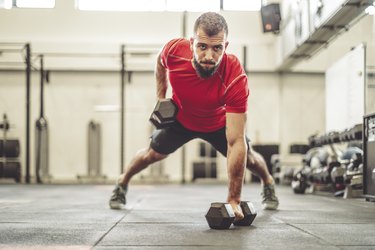
Poor posture is an issue that affects your health just as much as your appearance. Most commonly, aches and pains — like chronic low back pain — has been linked to bad posture, according to the National Institute of Neurological Disorders and Stroke.
Fortunately, even if you've slumped yourself into a less than ideal posture, upper-body exercises can help improve the way you sit and stand by strengthening the muscles along your backside from shoulders to hamstrings. And these exercises are even more effective when you incorporate dumbbells.
Video of the Day
Video of the Day
Below, Sergio Pedemonte and Alexa Teixeira, certified personal trainers at Your House Fitness, demonstrate seven of the best dumbbell exercises to help you feel stronger and stand taller.
Try These Dumbbell Exercises for Perfect Posture
1. Deadlift
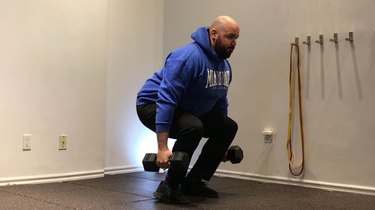
- Stand with your feet hip-width apart.
- Hold the dumbbells at your sides, palms facing in with your arms fully extended.
- Brace your core and lower the dumbbells toward the ground, keeping them along the sides of your leg. Focus on pushing your butt back, allowing your torso to lower and bend at the knees. Maintain a neutral spine throughout.
- Once the dumbbells reach your ankle, push through your heels to return to standing, driving your hips forward at the top.
- Repeat.
Tip
Deadlifts strengthen the lower back, glutes and core — muscles that are key to maintaining an upright torso. They also target the muscles along the spine and lower-body muscles like the quadriceps and hamstrings.
2. Romanian Deadlift
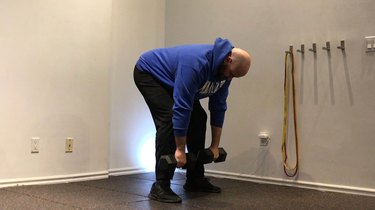
- Stand with your feet hip-width apart, knees slightly bent.
- Place the dumbbells in front of your thighs with your arms fully extended.
- Brace your core and lower the dumbbells toward the floor by pushing your hips back, keeping the weights along the front of your legs. Maintain the slight knee bend and neutral spine throughout.
- Once the dumbbells reach your mid-shin or you feel a stretch in your hamstring, return to an upright position by pushing through your heels, driving your hips forward at the top.
- Repeat.
Tip
The Romanian deadlift works to strengthen the posterior chain muscles (back and back of the legs). Strengthening these muscles also helps to reduce the risk of lower back pain.
3. Bent-Over Row
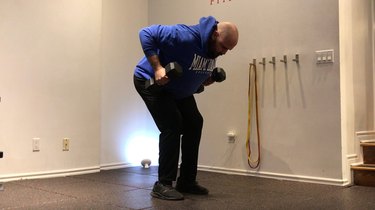
- Stand with your feet hip-width apart with your knees slightly bent.
- Bend your upper body forward, creating a 45-degree angle with your legs.
- Start with your arms fully extended out in front of you, palms facing inward. This is the starting position.
- While maintaining a neutral spine, pull the dumbbells toward the lower rib cage, keeping the elbows tight to the body. Always remember to squeeze the shoulder blades together when lifting the weight up.
- Lower the dumbbells back to the starting position and repeat.
Tip
The bent-over dumbbell row improves your posture by strengthening the muscles involved in pulling your shoulder blades together. This, as you might imagine, makes it easier to pull them down and back when you're standing up straight.
4. Rear Deltoid Fly
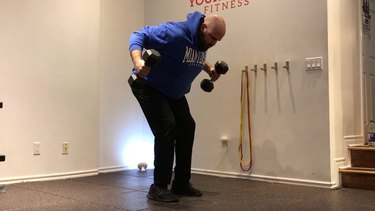
- Stand with your feet hip-width apart with your knees slightly bent.
- Bend your upper body forward, creating a 45-degree angle with your legs.
- Start with your arms fully extended out in front of you, palms facing inward. This is the starting position.
- Brace your core to create a neutral spine, then lift both arms out toward your side until they align with the shoulders, elbows slightly bent. Focus on squeezing the shoulder blades together.
- Return to the starting position and repeat.
Tip
The rear deltoid fly primarily targets the posterior deltoid — a muscle that helps rotate your shoulder. This helps prevent slouching, a trademark of poor posture.
Move 5: Prone Y Extension

- Using a bench or exercise ball, lie on your stomach facing the floor, holding a dumbbell in each hand, palms facing in.
- Fully extend your arms out in front of you in the shape of a Y.
- Brace your core and squeeze your shoulder blades together as you lift your arms as high as you can over your head.
- Pause for 2 to 3 seconds at the top.
- Slowly lower back down to the starting position.
- Repeat.
Tip
Prone Y extension strengthens the deltoids and rotator cuff while enhancing your shoulders' stability and mobility.
Move 6: Reverse V Raise
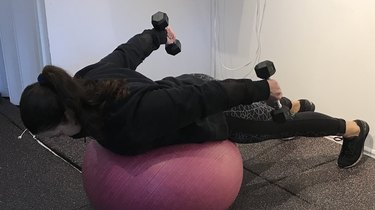
- Using a bench or exercise ball, lie on your stomach facing the floor, holding a dumbbell in each hand, palms facing in.
- Partially extend your arms out behind you in the shape of a V with a slight bend in your elbows.
- Brace your core and squeeze your shoulder blades together as you lift your arms back to parallel.
- Pause for 2 to 3 seconds at the top.
- Lower back slowly to the starting position and repeat.
Tip
Reverse V raises increase shoulder stability and mobility while building strength in the upper back. All of this promotes better posture.
Move 7: Renegade Row
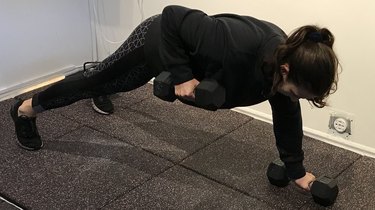
- Begin in a high plank, supporting each hand with a dumbbell. Place your hands slightly wider than shoulder-width, making sure to keep your wrists in line with your shoulders.
- Place your legs wider than shoulder-width to maintain balance and prevent rotation of the torso.
- Bracing your core, pull one dumbbell up toward your torso, keeping the other arm straight.
- Return it to the starting position and repeat with the other arm.
Tip
The renegade row improves your posture by boosting core stability and strengthening your lats — the largest muscle group in the back.